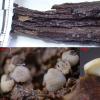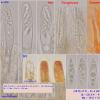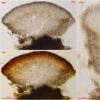
21-12-2025 21:32
Pol DebaenstHello, Garden, Burgweg 19, Veurne, BelgiumOn 10/1

22-12-2025 23:38
Patrice TANCHAUDBonsoir, récolte sur un mur en pierre, apothéci

21-12-2025 09:32
Hello.A tiny ascomycete found embedded in wood in

22-12-2025 00:47
Patrice TANCHAUDBonsoir, récolte à proximité du milieu dunaire

21-12-2025 21:40
Isabelle CharissouBonjour, j'aimerais connaitre les références de

21-12-2025 21:31
Pol DebaenstHello, Garden, Burgweg 19, Veurne, BelgiumOn 10/1

21-12-2025 21:31
Pol DebaenstHello, Garden, Burgweg 19, Veurne, BelgiumOn 10/1

20-12-2025 23:08
Patrice TANCHAUDBonsoir, récolte sur sol sablonneux dans l'arri�
 A few days ago I found this discomycete in Ottawa, ON, Canada, probably, Phaeohelotium. It was on a very wet and rotten, small piece of wood in an area that always wet and often flooded, under broadleaf shrubs.
A few days ago I found this discomycete in Ottawa, ON, Canada, probably, Phaeohelotium. It was on a very wet and rotten, small piece of wood in an area that always wet and often flooded, under broadleaf shrubs.Apothecia 1-1.7mm pulvinate.
Asci 8-spored, IKI- (I double checked), clearly croziers(-),
(107.7) 110.3 - 121.2 (122.8) × (12.4) 12.7 - 14.2 (15.3) µm; N = 7
Me = 116.3 × 13.6 µm ;
Paraphyses are cylindrical with multiguttulate VBs.
Ascospores fusiform, OCI=3-4, measure in H2O
(15.5) 17.5 - 21.4 (22.6) × (4.2) 4.4 - 5.2 (6) µm
Q = (3) 3.4 - 4.6 (5) ; N = 20
Me = 19.2 × 4.9 µm ; Qe = 4
Ectal excipulum textura angularis and brown.
I couldn't identify it with European keys. Maybe someone has an idea of what it could be.
Lots of pictures here.
https://inaturalist.org/observations/83985987
I still have a living specimen, so if something is missing I can check it.
Thank you for any help,
Igor
Such a name gave him Zotto, probably not yet published?
Let's wait for Zotto's opinion :)


Alnus incana probably is the most abundant species in that area.
I got an inamyloid reaction in IKI for the subiculum from a living specimen.
The rest look good for P. griseobrunneum inamyloid H- and my measurements get very close to HB 8295E, only asci a bit larger.
Thank,
Igor




